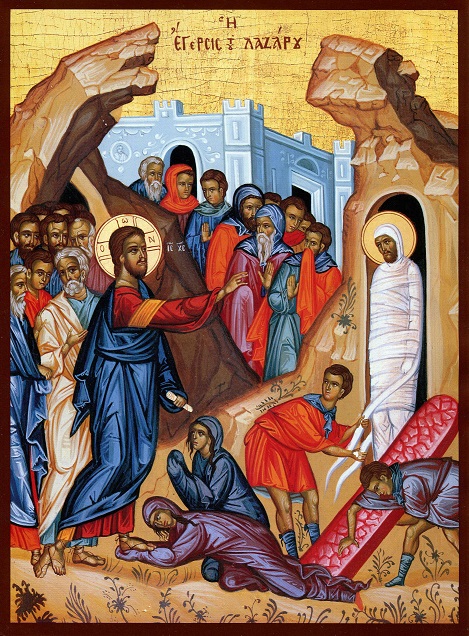

Assista os documentários sobre São Lázaro
Lendo o ícone da ressureição de Lázaro
A primeira fonte que nos fala da Festa da Ressurreição de Lázaro remonta ao século IV (Egéria, Diário de viagem, 29, 3- 6). A festividade atual, na tradição bizantina, parece derivar da hierosolimitana.
O Ícone da Festa poderia dar a impressão de não ser mais que uma simples transcrição gráfica do relato evangélico (Jo 11, 1- 44).
A parte superior do Ícone está limitada por dois conjuntos rochosos que deixam entrever, em sua confluência, as muralhas de uma cidade (Betânia) com um grupo dos seus habitantes. Semelhantes muralhas ameadas significam um estar fora da cidade.
Os únicos personagens com a cabeça aureolada são: Cristo e Lázaro, um diante do outro. A auréola de Cristo, é cruciforme. Veste-Se de túnica vermelha com manto verde: Sua natureza humana, envolta pela divindade. Sua mão direita está estendida, com o indicador, o médio e mínimo retos: é o mistério da Trindade. Os dois dedos reunidos recordam que em Cristo subsistem duas naturezas: a humana e a divina. Sua mão esquerda empunha um rolo.
Em frente a Cristo vemos o justo Lázaro, morto havia quatro dias, à entrada da gruta sepulcral, cuja pedra, por ordem do Mestre, foi removida por um homem, em atitude reverente diante do Vivificador. Um homem que, voltado para Cristo, está dizendo-lhe com o gesto de que “cheira mal”, recebe a ordem determinante: “Desatai-o e deixai-o andar”
Atrás do Messias, aparece o grupo dos doze Apóstolos. Pedro é o primeiro, reconhecível pela barba e cabelos crespos.
No primeiro plano, prostradas aos pés de Cristo, aparecem as duas irmãs de Lázaro, Marta e Maria. A segunda disse à Jesus a mesma frase que sua irmã: “Senhor, se tivesses estado aqui, o meu irmão não teria morrido”
A leitura do Ícone é um momento da meditação para nós. Ele abre nossos olhos e nossas vidas no horizonte indeterminado. Transporta-nos do mundo da morte no mundo da vida e da ressurreição. “O Cristo. alegria de todos, Verdade, Luz, Vida e Ressurreição do mundo, manifestou-Se na Sua bondade aos que estão sobre a terra, fez-Se modelo da Ressurreição, dando a todos o perdão divino”.
Fonte: G. Passarelli, O Ícone da ressurreição de Lázaro, 1996.
Reading the icon of ressurection of Lazarus
The first source that tells us about the Feast of the Resurrection of Lazarus dates back to the 4th century (Egéria, Diary of travel, 29, 3- 6). The current festivity, in the Byzantine tradition, seems to derive from the hierosolimitan one.
The Icon of the Feast could give the impression of being nothing more than a simple graphic transcription of the evangelical account (John 11, 1- 44).
The upper part of the Icon is limited by two sets of rocks that reveal, at their confluence, the walls of a city (Betânia) with a group of its inhabitants. Similar crenellated walls signify being outside the city.
The only characters with a haloed head are: Christ and Lazarus, facing each other. Christ’s halo is cruciform. He dresses in a red tunic with a green cloak: His human nature, enveloped by divinity.
His right hand is extended, with the index, middle and small fingers straight: it is the mystery of the Trinity. The two fingers brought together remind us that in Christ two natures exist: the human and the divine. His left hand holds a rolling pin.
In front of Christ we see the righteous Lazarus, who had been dead for four days, at the entrance to the burial cave, whose stone, by order of the Master, was removed by a man, in a reverent attitude before the Life-giver. A man who, facing Christ, is telling him with a gesture that he “smells bad”, receives the decisive order: “Untie him and let him walk”
Behind the Messiah, the group of twelve Apostles appears. Pedro is the first, recognizable by his beard and curly hair.
In the foreground, prostrate at the feet of Christ, appear Lazarus’ two sisters, Martha and Mary. The second said to Jesus the same sentence as her sister: “Lord, if you had been here, my brother would not have died.”
Reading the Icon is a moment of meditation for us. It opens our eyes and our lives to the indeterminate horizon. Transport us from the world of death to the world of life and resurrection. “The Christ, joy of all, Truth, Light, Life and Resurrection of the world, manifested Himself in His goodness to those on earth, became a model of the Resurrection, giving divine forgiveness to all.”
Source: G. Passarelli, The icon of the resurrection of Lazarus, 1996.
Fonte do ícone: Aperges
Produzido por
Consulte a Agenda do Museu a partir de 2025 e o visite quando receber sua confirmação de visita em seu email ou whatsapp.
Por se tratar de um museu particular, é necessário se cadastrar na Comunidade MuMi e customizar sua visita.
Criação e Tecnologia: Clayton Tenório @2025 MuMi – Museu Mítico